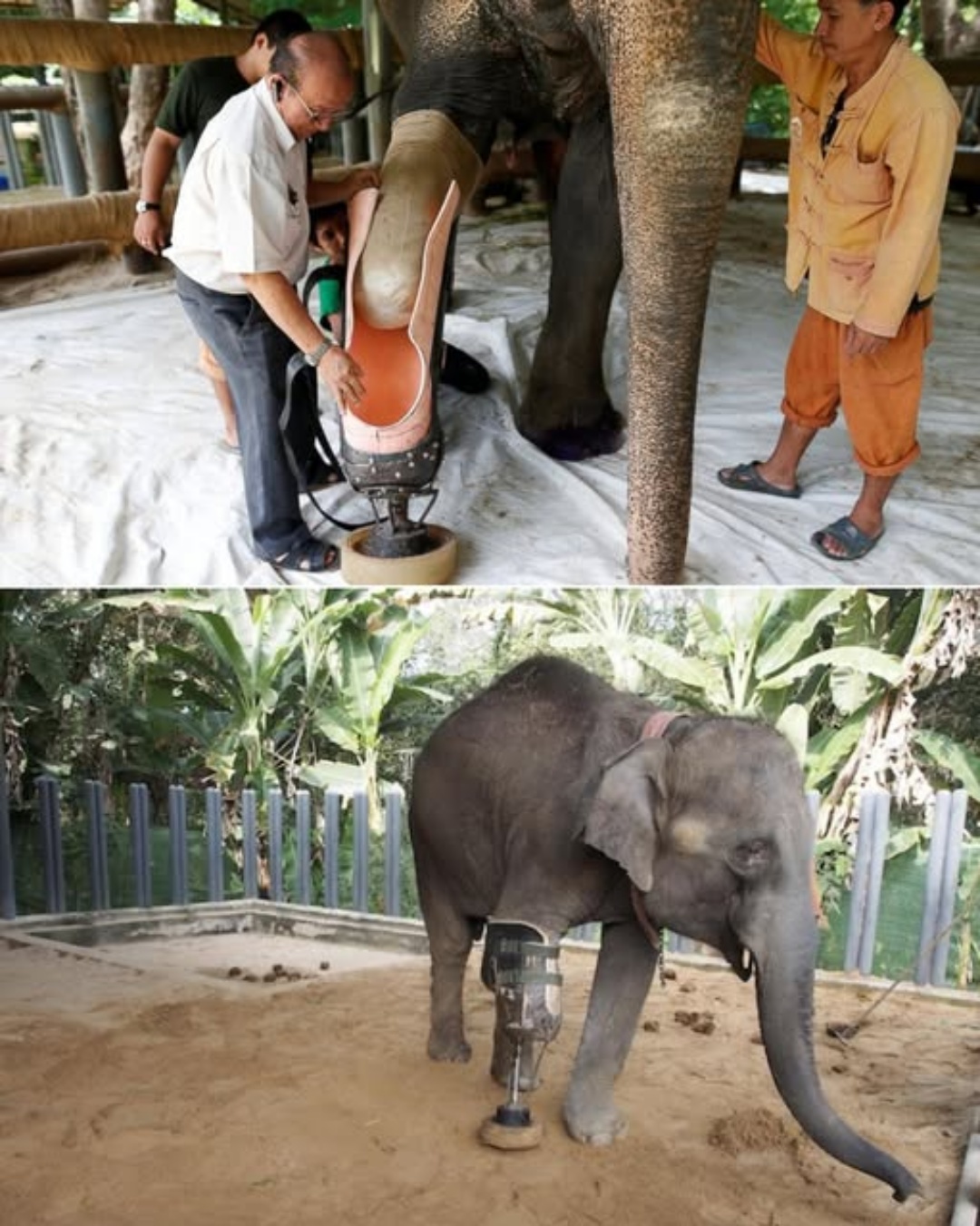From Landmine to Legacy: Mosha’s Story of Survival.
In the dense forests along the Thai–Myanmar border, danger sometimes hides where the earth looks harmless.
One step, one wrong place, can change everything.
For a young elephant calf named
Mosha, that step came far too soon.
Barely seven months old, she wandered alongside her mother when her foot struck a landmine buried beneath the soil.
The explosion tore through her front leg.
In an instant, the joy of her early days was replaced by agony.
For most elephants, such an injury is fatal.
An elephant’s massive body, weighing several tons, rests heavily on all four legs.
Without one, the balance is lost, the weight unbearable.
For Mosha, the wound was not just a gash—it was a sentence that threatened her very survival.
But fate had not abandoned her.

Rescuers brought her to the Friends of the Asian Elephant Hospital (FAE) in Lampang, Thailand—the first hospital in the world dedicated solely to elephants.
There, she received emergency care, food, and comfort.
She was safe from the dangers of the forest, but her future still hung in the balance.
Doctors, veterinarians, and caregivers faced an impossible question: how do you help an animal so massive, so dependent on its legs, to live with only three?
The answer came in the form of human innovation, compassion, and determination.
The team designed something never before attempted—an artificial limb for an elephant.
It was a daring experiment.
Could a creature weighing over 1,500 kilograms learn to walk again with a prosthetic?
Would her body accept it?
Would she adapt?
The day the prosthetic was fitted for the first time, Mosha hesitated.
The strange, foreign object was strapped carefully to her leg.She shifted uncertainly, testing the ground beneath her.
The staff watched, breath held.
And then—she stepped forward.
Awkward at first, unsteady, but undeniably moving.
A new rhythm, a new chance.
Step by step, wobble by wobble, Mosha began to walk again.
She became the first elephant in the world to walk on an artificial limb.
From that day, Mosha’s life transformed.
Her prosthetic had to be replaced and adjusted as she grew, but each new fitting became a testament to her resilience.
She adapted quickly, learning how to use her new leg not just to stand, but to walk, to explore, even to play.
Caregivers often described her spirit as gentle but determined.
She was not defined by the explosion that had scarred her, nor by the steel and plastic that now supported her.
She was defined by her will to live.
Visitors who came to FAE were often moved to tears when they saw her.
Children pressed their faces against the barriers, watching an elephant who had faced death and found a way forward.
Adults, hardened by life’s struggles, softened in her presence, reminded that survival is possible even after the deepest wounds.
Mosha became more than a patient.
She became a symbol.
Her story spread across the globe.
Images of the elephant with a prosthetic leg appeared in newspapers, documentaries, and exhibitions.
She reminded the world of two truths: first, that the shadow of war and violence reaches even into the animal kingdom; and second, that compassion and innovation can bring light into the darkest of places.
Landmines—human inventions of destruction—had nearly ended her life.
But human hands also built her new leg, carried her through recovery, and gave her a second chance.
Mosha became living proof that kindness can undo, at least in part, the harm caused by cruelty.
Through the years, her story has inspired countless people.
For amputees, she is a beacon of hope.
For conservationists, she is a call to protect.
For ordinary people facing hardship, she is a reminder that brokenness does not mean the end.
Every step she takes is a triumph.
Every day she lives is a message.
Mosha’s journey is not without challenges.
Her prosthetic must be regularly replaced to match her growing weight and shifting body.
Her caregivers constantly monitor her health, ensuring her remaining legs are not strained by imbalance.
But through it all, her eyes still shine with quiet resilience, and her trunk still reaches out in curiosity and trust.
When visitors see her walking across the sanctuary, they often describe a surge of emotion that words cannot quite capture.
It is not pity they feel—it is awe.
Awe at her strength, awe at her ability to adapt, awe at the bond between human compassion and animal endurance.
Mosha reminds us that healing is possible.
Not always perfect.
Not always complete.
But real.
And sometimes, that is enough to change the world.
Because Mosha did not just learn to walk again.
She taught us all to see differently.
To see beyond scars, beyond deformities, beyond limitations.
To see resilience, hope, and the quiet beauty of survival.
In her, we see a truth as vast as the forests she once roamed:
That life, though fragile, is also fiercely determined.
That hope, though sometimes hidden, can rise again.
And that love, when given freely, can rebuild what was once broken.
Mosha, the elephant who walks on a prosthetic leg, is more than an animal with a story.
She is a living symbol of what it means to endure.
She is a reminder that we, too, can carry our wounds with courage.
She is proof that even the heaviest burdens can be lifted—one step at a time.
